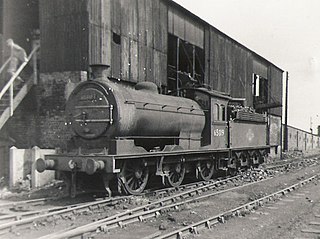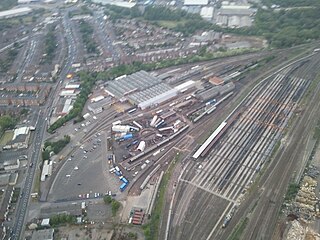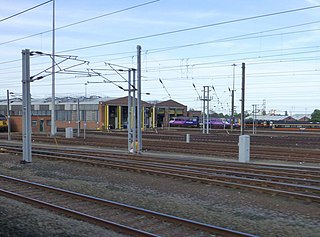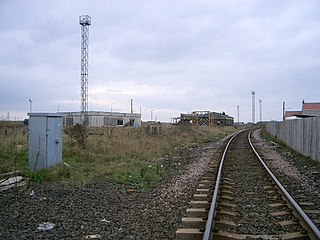
The Tanfield Railway is a 4 ft 8+1⁄2 instandard gauge heritage railway in Gateshead and County Durham, England. Running on part of a former horse-drawn colliery wooden waggonway, later rope & horse, lastly rope & loco railway. It operates preserved industrial steam locomotives. The railway operates a passenger service every Sunday, plus other days, as well as occasional demonstration coal, goods and mixed trains. The line runs 3 miles (4.8 km) between a southern terminus at East Tanfield, Durham, to a northern terminus at Sunniside, Gateshead. Another station, Andrews House, is situated near the Marley Hill engine shed. A halt also serves the historic site of the Causey Arch. The railway claims it is "the world's oldest railway" because it runs on a section dating from 1725, other parts being in use since 1621.

The North Tyneside Steam Railway and Stephenson Steam Railway are visitor attractions in North Shields, North East England. The museum and railway workshops share a building on Middle Engine Lane adjacent to the Silverlink Retail Park. The railway is a standard gauge line, running south for 2 miles (3.2 km) from the museum to Percy Main. The railway is operated by the North Tyneside Steam Railway Association (NTSRA). The museum is managed by Tyne and Wear Archives and Museums on behalf of North Tyneside Council.

The BR Standard Class 4 2-6-0 is a class of steam locomotive designed by Robert Riddles for British Railways (BR). 115 locomotives were built to this standard.

A motive power depot (MPD) or locomotive depot, or traction maintenance depot (TMD), is where locomotives are usually housed, repaired and maintained. They were originally known as "running sheds", "engine sheds" or just "sheds". Facilities are provided for refuelling and the replenishing of water, lubricating oil and grease and, for steam engines, the disposal of ash. There are often workshops for day-to-day repairs and maintenance, but locomotive building and major overhauls are usually carried out at locomotive works.

The North Eastern Railway (NER) Class P3, classified J27 by the LNER, is a class of 0-6-0 steam locomotive. The P3 Class was designed by Wilson Worsdell and was a relatively minor modification of the existing North Eastern Railway Class P2. The most significant change was a deeper firebox with shallower sloping fire grate. This was achieved by raising the boiler slightly, and by reducing the clearance between the firebox and the rear axle. The P3 Class were a freight engine by nature and used for hauling long trains of freight.

St Blazey engine shed is located in Par, Cornwall, United Kingdom, although it is named after the adjacent village of St Blazey. It was built in 1874 as the headquarters of the Cornwall Minerals Railway but for many years was a depot of the Great Western Railway. The current depot operator is DB Cargo and the depot TOPS code is BZ.

Old Oak Common TMD was a traction maintenance depot located west of London Paddington, in Old Oak Common. The depot codes were OC for the diesel depot and OO for the carriage shed. In steam days the shed code was 81A.

Tyseley TMD is a railway traction maintenance depot situated in Tyseley, Birmingham, England.

Heaton TMD is a railway traction maintenance depot situated in the Heaton area of Newcastle upon Tyne, England, it is located next to the East Coast Main Line, around 2 miles (3 km) east of Newcastle Central station. Heaton was a sub-shed of Gateshead between 1963 and 1967.

Thornaby TMD was a railway traction maintenance depot situated in Thornaby, England, latterly operated by DB Schenker. The depot was situated to the east of Thornaby, on the northern side of the line to Middlesbrough.

Stratford TMD was a traction maintenance depot located in Stratford, London, England, close to the Great Eastern Main Line. It was located just west of Stratford station, on a site now occupied by Stratford International station. The depot was, at one time, the biggest on the London and North Eastern Railway with locomotives covering duties from express services to freight workings in London's docks.
There were a number of engine sheds and railway works located in York. The large York North engine shed became the National Railway Museum in 1975.

Ipswich engine shed was an engine shed located in Ipswich, Suffolk on the Great Eastern Main Line. It was located just south of Stoke tunnel and the current Ipswich railway station. Locomotives accessed the site from Halifax Junction which was also the junction for the Griffin Wharf branch of Ipswich docks. The depot opened in 1846 and closed in 1968 although the site remained in railway use for a further thirty years.
Carnforth MPD (Motive Power Depot) is a former London Midland and Scottish Railway railway depot located in the town of Carnforth, Lancashire, England.
West Auckland railway station served the villages of St Helen Auckland and West Auckland in County Durham, England, between 1833 and 1962. It was on the railway line between Bishop Auckland and Barnard Castle. There was a locomotive depot, which was the only one to be both closed completely and later reopened by the London and North Eastern Railway.

Darlington TMD was a railway traction maintenance depot situated in Darlington, England. The depot code was 51A during the steam era and DN later on. It had several locations. It mainly provided for Teesside freight and local passenger routes to Penrith, Richmond and Saltburn.

Botanic Gardens TMD is a traction maintenance depot in Kingston upon Hull in Yorkshire, England. As built it was one of the principal steam engine sheds in the Hull area, Botanic Gardens was the one closest to the main Hull Paragon station and its locomotives were responsible for working passenger services in the area. This entry also covers the engine sheds in the Paragon area that preceded Botanic Gardens.

Blyth Cambois TMD was a traction maintenance depot located in Blyth, Northumberland, England. The depot was situated on the west side of the branch line from Bedlington Junction to Blyth Docks.
Southport MPD (Motive Power Depot) is a former LMS railway depot located in the town of Southport, Merseyside.
Scarborough engine sheds are two locations used to service locomotives in the town of Scarborough, North Yorkshire, England. The first location was used between 1845 and 1963, and thereafter, locomotives were stabled within the station. In 2019, TransPennine Express opened up a new single road facility to service their leased Class 68 locomotives used on the Liverpool to Scarborough services.
















